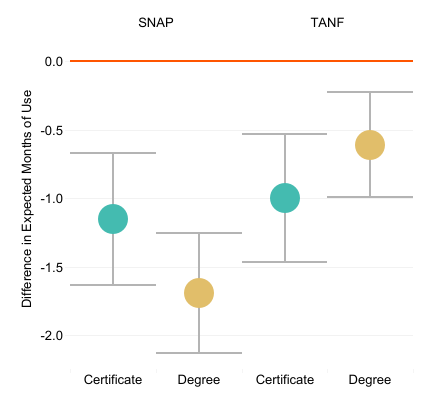Recent Research: Public Assistance Usage and Higher Education
Ari Fenn, Ph.D., Senior Researcher
January, 17, 2023

This study establishes the relationship between completing a degree or technical certificate, a postsecondary program, and using public assistance. The public assistance programs of interest are Supplemental Nutrition Assistance Program (SNAP), also known as “food stamps,” and Temporary Assistance for Needy Families (TANF), also known as “welfare.” The SNAP and TANF data come from the Department of Workforce Services (DWS), the employment industry, and the Utah System of Higher Education (USHE). This study used everyone whose first month of public assistance use was between January 2009 and December 2014. The data was aggregated into six-month observation periods. Anyone who first used public assistance between January 2009 and December 2014 was included, and public assistance use was measured for five years after the initial month of public assistance use.
This study finds that historically marginalized groups are overrepresented as public assistance users. Women account for 72% more of the TANF population than they do of the overall Utah population. Black Utahns account for 40% more of the SNAP users and 193% more of the TANF users than of the Utah population. Those who completed a post-secondary program were younger and more likely to be white than those who did not complete a postsecondary program.
There are differences in employment between those who complete a postsecondary program and those who do not. Most TANF and SNAP users who did not complete a postsecondary program were unemployed at the beginning of assistance use. Furthermore, the largest single industries were industries with below-average wages. After the final spell of public assistance use, those who completed a postsecondary program were more likely to be employed than those who did not. Additionally, those who completed a postsecondary program were more likely to be employed in industries with above-average wages.

The research establishes how public assistance use patterns change after completing a postsecondary program (Fig. 1). The method compared how patterns of use changed for those who completed a postsecondary before and after completion. Those who did not graduate helped to create a baseline use trend. After completion, those who completed a postsecondary program used between 1.6 and 0.6 fewer months of assistance during each subsequent six-month period. This result is heavily driven by those who graduated during the early years of observation.
This research describes the population that used public assistance and shows how the completion of postsecondary education changes the use of public assistance. The population that used public assistance is more female and less white than that of Utah as a whole. Those who completed a postsecondary program are more likely to be employed in better-paying jobs at the end of public assistance use. Completing a postsecondary program led to fewer expected months of public assistance use post-completion than pre-completions trends would have suggested.
For more on this research, check out the data narrative and full report.